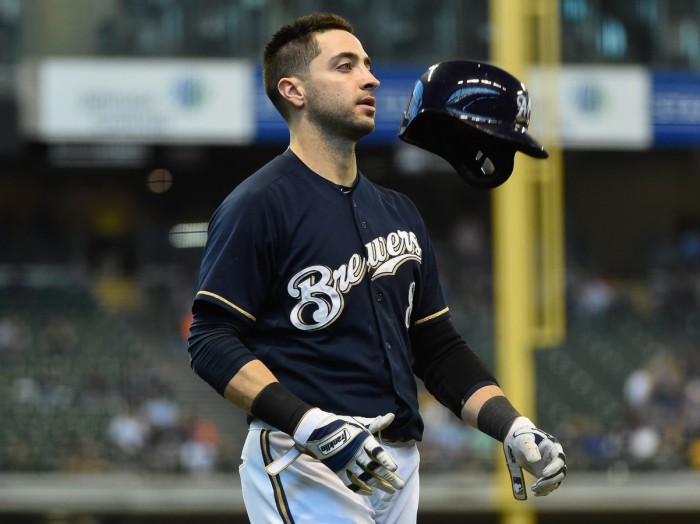The combined 2011 and 2012 version of Ryan Braun was one of baseball’s best players. He won the 2011 NL MVP and posted back-to-back six-win seasons. However, the 31-year-old has spent the last three years as a good — but not great — player. In short, he has transitioned from being one of the game’s elite hitters to being merely very good, and that combines with his lack of true defensive value to create an above-average outfielder but no longer a franchise-defining superstar.
Milwaukee, though, has Braun locked up through 2020, so this isn’t a case where the team can simply shrug as its fading superstar is no longer worth his contract. The Brewers will expect to contend again before Braun’s contract expires. Thus, assessing in which area their star right fielder has faded is important as it will help us understand what sort of value Milwaukee should expect — and whether there is any chance of a return to his 2012 form.
During his peak, Braun’s primary skill was his rare ability to hit for average and power, without striking out a commensurate amount. In 2011, he struck out just 14.8 percent of the time (well below the league-average of 18.6 percent) while posting a .265 ISO, which ranked sixth-overall in all of baseball. His incredible talent to both put the ball in play and hit the ball hard enabled him to extract the most possible value out of each swing.
Now, he is not that same player. His strikeout rate has climbed over the last four years — from roughly 15 percent in 2011 to around 20 percent over the last three years — and his ISO has dipped from a high-water mark of .276 in 2012 to only .200 since. While neither change individually has spelled doom from his days as an MVP candidate, they have combined to take him from an elite hitter with a TAv (True Average) in the .340 range to merely a good one with a TAv roughly 50 points lower. Remember, a league-average TAv is approximately .260.
There is good reason to believe that this is a substantive change in Braun’s profile. His ground-ball percentage has risen since his MVP season, and research by BP’s own Russell Carleton indicated that ground-ball rates stabilize quite quickly. For this reason, the three years of data available regarding this new version of Braun is plenty to determine his changed skill level.
Ground balls are also (obviously) less likely to be hit for extra bases than are fly balls or line drives. The fact that Braun’s hitting profile has changed seriously impacts his production. Instead of being a dynamic hitter who can both get on base and hit for power at an elite level, Braun has turned into a more “normal” performer with above-average patience and power.
Braun’s increased ground-ball rate does appear to be a part of his profile going forward, but an interesting aspect of his swing habits is that not much appears to have changed. He is chasing pitches outside of the zone slightly more often, but he is making roughly the same amount of contact both in the strike zone and outside of it. There has not been a significant decrease in his ability to hit pitches in the strike zone (89.5 percent in 2015, 88.0 percent for his career), which might have indicated a severe drop in bat speed. Instead, the fading ISO is the main evidence of physical decline. Given his age (31) and the three years of evidence, we can conclude that the 2011, or even 2012, version of Braun will not return.
All of this time has been spent on Braun’s bat because that is, of course, his primary moneymaker, but his speed and defense also contribute to his value. While he has never been lauded for his defense, he was a relatively prolific base stealer at one point in his career. That skill, however, has — not surprisingly — declined with age, as his season-high in stolen bases since 2013 is just 11. Interestingly, though, he already has nine this year; although we know that speed should fade from essentially the point when players reach the big leagues, this might indicate that Braun has a bit more athleticism left than we would otherwise assume. It could also indicate a strategic change from Ron Roenicke to new manager Craig Counsell.
Similarly, this has resulted in less of a defensive decline than one might expect from a 31-year-old outfielder. Baseball Prospectus, FanGraphs, and Baseball-Reference do not agree on Braun’s value as an outfielder for any of the last three seasons, but they all generally rate him as defensively replacement level over that time. This seems bad, but his first few seasons were so atrocious that the fact he has stabilized at even this level is actually a minor victory.
Ultimately, though, any analysis of Ryan Braun’s baserunning and defense tells us what we need to know: his bat is no longer good enough to help us ignore his deficiencies. If his move to right field is permanent, his positional value will get a slight bump, but his calling card must always be his bat. The speed and defense athleticism indicators are a positive — as is his stable contact rate — but his drop in power and increase in strikeouts are worrying signs. The Brewers do not seem as if they will get a valuable return on their $20 million per year investment.
